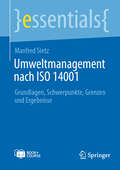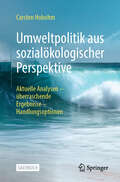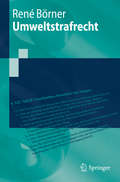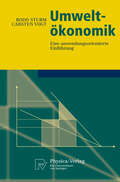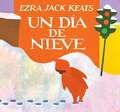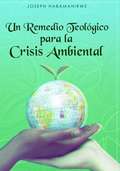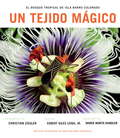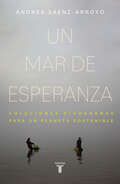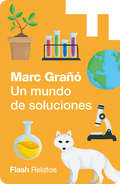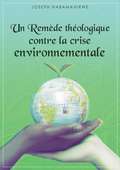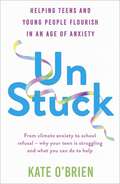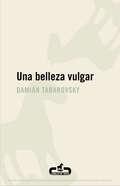- Table View
- List View
Umweltgerechtigkeit: Arbeit, Sozialisation, Teilhabe und Gesundheit (essentials)
by Regine GrafeUnter Einbindung des Umweltgerechtigkeitsansatzes, der die Gesundheitsgerechtigkeit impliziert, werden Fragen zur Bedeutung von non-formaler und formaler Bildung im Kontext der Sozialisation des Einzelnen in einer sich verändernden Gesellschaft gestellt. Wieviel und vor allem welche Art von Teilhabe ermöglicht die Gesellschaft aktuell und vor welchen Herausforderungen steht sie in Zukunft? Welche zukunftsfähigen Bildungsinhalte müssen vermittelt werden für die sich aktuell rasant verändernde Gesellschaft? Es bedarf nicht nur neuer Wissens- und Kompetenzvermittlung, sondern auch eines Paradigmenwechsels beim Arbeitsschutz. Was bedeutet das für die Gesellschaft und den Einzelnen? Es geht dabei auch um Assimilation, Integration und Onboarding. Wer wird die notwendigen Bildungsinhalte zukünftig vermitteln und mit welchem Anspruch? Welche Rolle wird die Arbeits(um)welt dabei spielen? Fragen, die aktuell gestellt werden müssen, um gesellschaftspolitische Antworten darauf zu finden.
Umweltgerechtigkeit: Zusammenhang, Verantwortung und Stellschrauben (essentials)
by Regine GrafeAusgehend vom Konzept des „Sozialen Raumes“, der im ganzheitlichen Begriff der Umwelt verankert ist, stellen sich Fragen nach dem Einfluss sozialer Räume auf den Menschen. Welchen Einfluss haben Lern- und Arbeitsumwelt? Wie ist es mit Chancengleichheit des Einzelnen und seiner Teilhabe bestellt? Wie hängen Wissen und Bildung zusammen? Nicht jeder, der viel weiß, ist auch gebildet. Welche Bedeutung hat die antizipatorische Bildung in der Familie und welche der Arbeits-, Lern- und Lebensumwelt? Fragen, die zweifelsohne mit sozioökonomischen Bedingungen eng zusammenhängen. Aber ist das ausschließlich darauf zu reduzieren? Wie wird die Zukunft der Arbeitswelt als Wissenswelt und damit deren Einfluss auf den Einzelnen aussehen? Welche Kompetenzen werden erforderlich sein für diese neue Arbeitswelt und wer wird sie vermitteln? Welche Bildungsinhalte werden deren soziale Räume vermitteln und mit welchem Ziel? Wenn Wissen zur Ware wird und damit beliebig, wer übernimmt dann die Verantwortung für dessen Vergegenständlichung als Produkt?
Umweltmanagement nach ISO 14001: Grundlagen, Schwerpunkte, Grenzen und Ergebnisse (essentials)
by Manfred SietzUmweltmanagement eines Unternehmens bedeutet, die Umweltauswirkungen minimierend zu managen, um die Qualität unserer Umwelt zu erhalten oder zu verbessern. Managen bedeutet in der Originalübersetzung etwas zu verwalten. Also eine Aufgabe mit Verantwortung, Zielen und Aktivitäten. Alle diese Managementtools werden zuzusammengefasst in der weltweit gültigen und zertifizierbaren Norm ISO 14001.
Umweltpolitik aus sozialökologischer Perspektive: Aktuelle Analysen - überraschende Ergebnisse - Handlungsoptionen
by Carsten HobohmAngesichts einer zunehmend bedrohlichen Kulisse stellt sich die Frage, wie der Klimawandel, die Intensivierung der Nutzung von Ökosystemen und die Bedrohung der Artenvielfalt das soziale und kulturelle Leben beeinflussen. In den Medien haben Katastrophenmeldungen zweifellos zugenommen. Doch in welcher Weise das gesellschaftliche Leben oder die Menschheit insgesamt durch Umweltkatastrophen konkret bedroht ist, wird bislang nur selten in ausreichender Detailschärfe dargestellt. Mit dieser Analyse wird versucht, den Knoten der gelegentlich einseitigen Betrachtung zu lösen und den Blickwinkel um einige Möglichkeiten der Ausgestaltung von Zukunft zu erweitern. Eine ganze Palette von Möglichkeiten zielt darauf ab, den Fokus der global dunklen, gleichzeitig unscharfen oder sogar verschwommenen Perspektiven um positive Ansätze in der lokalen und regionalen Dimension zu erweitern. Möglichkeiten sind reichlich vorhanden, aber sie sind nicht zum Nulltarif zu realisieren.
Umweltrecht: Ein Lehrbuch (Umweltwissenschaften Ser.)
by Ulrich Smeddinck Rainer Wolf Winfried Kluth Guy Beaucamp Susanna Much Rüdiger Nolte Hans-Jürgen Sack Anne-Barbara WalterDieses Lehrbuch bietet eine Einführung in das Umweltrecht insbesondere auch für Praktiker und Nicht-Juristen. Ausgehend von den allgemeinen Grundlagen werden die wichtigsten Bereiche des Umweltrechts vorgestellt. Als wichtige übergreifende Materie ist das Klimaschutzrecht berücksichtigt. Zu Steigerung des Gebrauchswertes in der Praxis wird ein besonderer Akzent auf die Themen Rechtsschutz und das Umweltstrafrecht gesetzt.
Umweltschutz in katholischen Orden: Interpretieren, Bewerten und Verhandeln als Teilprozesse der Glokalisierung (Veröffentlichungen der Sektion Religionssoziologie der Deutschen Gesellschaft für Soziologie)
by Jiska GojowczykUmweltschutzziele wie die Bewahrung der Schöpfung werden selbst in hierarchisch organisierten Gemeinschaften wie katholischen Orden auf unterschiedlichste Weise interpretiert, bewertet und verhandelt. Während manche Mitbrüder der gleichen Kommunität basierend auf einem Ziel ganz verschieden handeln, interpretieren andere es auch über geographische und nationale Grenzen hinweg sehr ähnlich. Mit der vorliegenden ethnographischen Studie werden die Unterschiede und Gemeinsamkeiten erkennbar. Es zeigt sich: Das Ziel einer Gemeinschaft markiert nicht einen Weg, sondern viele. Wer religiösen Umweltschutz untersucht, sollte deswegen mehr als einen Weg bedenken – einschließlich Umleitungen und Kreuzungen.
Umweltstrafrecht (Springer-Lehrbuch)
by René BörnerDas vorliegende Lehrbuch vermittelt Studierenden und Rechtspraktikern eine schnelle Orientierung und sichere Wege zur Lösung praxisnaher Fälle im Umweltstrafrecht, dessen Bedeutung im Studium und in der Rechtspraxis rasant zunimmt. Die tiefgründig behandelte Rechtsdogmatik wird anhand klarer Strukturen und zahlreicher Beispiele didaktisch aufbereitet.
Umweltökonomie (Studienwissen kompakt)
by Marc RingelDieses Lehrbuch führt kompakt in das Gebiet der Umweltökonomie ein. Es beleuchtet ökologische und ökonomische Sichtweisen zu Umweltproblemen und erörtert daraus abgeleitete Prinzipien der Umweltökonomie. Ökonomische Instrumente staatlicher Umweltpolitik werden übersichtlich und klar verständlich erklärt. In abgegrenzten Lerneinheiten beleuchtet das Buch den Anwendungsbereich Klimaschutzpolitik sowie die staatliche Förderung von „grünem Wachstum“, wodurch ein Bogen von der umweltökonomischen Theorie zur politischen Praxis geschlagen wird. Kurze Lerneinheiten, versehen mit Verweisen auf praktische Anwendungsfälle und begleitende Lernkontrollen, erleichtern eine Einarbeitung in das Thema sowie eine schnelle und fundierte Wissensvermittlung.Zusätzliche Fragen per App: Laden Sie die Springer-Nature-Flashcards-App kostenlos herunter und nutzen Sie exklusives Zusatzmaterial, um Ihr Wissen zu prüfen.
Umweltökonomik
by Bodo Sturm Carsten VogtUmweltökonomik bedeutet, nach Mitteln zur möglichst effizienten Bereitstellung von Umweltgütern wie etwa sauberes Wasser und Klimaschutz zu suchen. Dieses Buch führt in die Grundlagen der Umweltökonomik ein, stellt aber auch aktuelle Forschungsfragen vor. Die Theorie externer Effekte sowie die Besonderheiten von Umweltgütern werden ausführlich erläutert, ebenso umweltpolitische Instrumente - Steuern, Emissionshandel und Auflagen - zur Lösung von umweltrelevantem Marktversagen. Dabei legen die Autoren Wert auf Anwendungsorientierung und verständliche Darstellung mit geringem Einsatz formaler Methoden. Fallstudien beschäftigen sich mit externen Kosten des Verkehrs, der Ökologischen Steuerreform, dem EU-Emissionshandel und CO2-Standards für PKWs. Ein Themenschwerpunkt gilt dem Klimawandel und der Klimapolitik.
Un Año Con Melissa
by Marcela Gutiérrez Bravo Alessandro Caselli Marzia BosoniRespeto por el ambiente, por los animales y por nosotros mismos, eso es de lo que tratan los diálogos entre Melissa, una niña de seis años con muchos deseos de comprender el mundo, y el Señor Gato, un sagaz gato vagabundo. Seis historias para contar un año de vida de la niña y para compartir un poco de la sabiduría que el gato ha reunido por las calles del mundo. Entre una historia y la otra, el gato se dirige a los padres y a los adultos en general para pedirles también a ellos el detenerse un momento y reflexionar sobre temas importantes de ecología, dolor y amistad. Un libro para niños, pero también un libro para grandes que saben todavía encontrar tiempo para hablar con los pequeños. Y con los gatos.
Un Día De Nieve
by Ezra Jack KeatsTraducción en español del cuento clásico ganador de la Medalla Caldecott, Un día de nieve.Es un día de nieve y Pedro sale a explorar. Mientras pasea entre montones de nieve apilada y observa a los niños grandes jugar a tirarse bolas gigantes--descubre los surcos que dejan sus pies en la nieve espesa y lo divertido que es hacer figuras de ángeles en la nieve."This translation of Keats's original Caldecott Medal winner captures the physical and emotional experiences of Peter and his delight in a snowfall."—School Library Journal
Un Remedio Teológico para la Crisis Ambiental
by Joseph HabamahirweLas conferencias internacionales sobre el medio ambiente, como la de Río en 1992, han hecho buenas políticas ambientales. Desafortunadamente, tales políticas no se han implementado lo suficiente. Esta situación refleja la falta de interés por parte de los países desarrollados, así como la falta de tenacidad por parte de los países en desarrollo. Por lo tanto, dicha tenacidad es necesaria para resolver el problema aparentemente insoluble de la contaminación ambiental. Las Naciones Unidas han establecido un Programa Ambiental (PNUMA) para abordar los problemas ambientales a nivel mundial. Aún así, hay mucho por hacer. Este libro presenta el estado de la actual crisis ambiental global, sus causas y efectos, tanto para los seres humanos como para la naturaleza misma. Hace un llamado a activistas ambientales, científicos, estudiantes, conferenciantes, líderes eclesiásticos y líderes políticos para detener esta crisis que podría persistir durante muchos años y empeorar progresivamente si el mundo no llega a una solución pronto.
Un Tejido Magico: El Bosque Tropical de Isla Barro Colorado (Spanish Edition)
by Christian Ziegler Egbert Giles LeighBarro Colorado Island is the crown jewel of the Smithsonian Tropical Research Institute, and the most thoroughly studied tropical rainforest on Earth. This book reveals the extreme interconnections of life in a tropical forest, with lavishly beautiful full-color photographs. It gives an eyewitness view of the fascinating biodiversity, ecology, and evolution of tropical forests. A Magic Web has particular value for scientists and environmentalists, as it offers a comprehensive review of more than 100 years of biological research of a tropical rainforest. It comprises the most important ecological and evolutionary processes that shape life in a tropical forest and contribute to its incredible diversity. Lastly, this beautiful volume clearly shows why the conservation of tropical forests are vital for Earth's future. Isla de Barro Colorado es la joya de la corona del Instituto Smithsonian de Investigaciones Tropicales, y la selva tropical más estudiado en la Tierra. Este libro revela las interconexiones extremas de la vida en un bosque tropical, con ricamente hermosas fotografías a todo color. Da una vista ocular de la fascinante biodiversidad, la ecología y la evolución de los bosques tropicales. Un Tejido Mágico tiene un valor especial para los científicos y los ecologistas, ya que ofrece una revisión completa de más de 100 años de investigación biológica de la selva tropical. Se compone de los procesos ecológicos y evolutivos más importantes que dan forma a la vida en un bosque tropical y contribuyen a su increíble diversidad. Por último, este hermoso volumen muestra claramente por qué la conservación de los bosques tropicales son vitales para el futuro de la Tierra.
Un mar de esperanza: Soluciones ciudadanas para un planeta sostenible
by Andrea Sáenz-ArroyoUn viaje físico e intelectual por distintas sociedades que revela formas de relacionarnos con el planeta más amables e inteligentes. Abundan las historias apocalípticas sobre el desastre ambiental que nuestra forma de vivir ha ocasionado. ¿Cuál es el futuro de la humanidad ante la inminente tragedia de haber dañado profundamente a la Tierra, el único hogar con el que contamos hasta el día de hoy? En Un mar de esperanza, Andrea Sáenz-Arroyo, una bióloga marina con un doctorado en Economía ambiental, nos guía por un viaje personal a través de sociedades e ideas contrastantes, y llega a la siguiente conclusión: el arribo de la era de la comunicación nos revela que degradar nuestro entorno y despojar los recursos de otros para satisfacer nuestras necesidades no sólo es poco inteligente, sino evolutivamente inviable.La buena noticia es que formas distintas al modelo hegemónico que establece cómo relacionarnos conla naturaleza están por todos lados y la información fluye hoy en una especie de red neuronal. La gran característica que nos distingue de las demás especies -nuestra enorme capacidad de aprendizaje social- nos está llevando a adoptar rápidamente esas formas en nuestra vida diaria y, quizá lo más importante, a confrontar colectivamente lo que, gracias a nosotros mismos, amenaza nuestro bienestar: el cambio climático. En un lenguaje sencillo, capaz de captar la atención de un lector preocupado por su mundo, Sáenz-Arroyo nos guía por un viaje físico e intelectual en el que las distintas sociedades revelan una forma menos nociva de relacionarnos con el mundo natural. Cada capítulo relata un viaje a territorios contrastantes, conoceremos de cerca a los indígenas de las islas Fiji, los pescadores de Baja California y las amas de casa de California de la década de los setenta. Este viaje nos revela miradas fuera de lo convencional para vivir en armonía con la naturaleza. Un mar de esperanza es un libro para todas las personas sedientas de soluciones ante la crisis ambiental, un respiro fresco y, como su nombre lo dice, un aire esperanzador en esta tormenta global de desasosiego.
Un mundo de soluciones
by Marc GrañóHay un mundo de soluciones para frenar el cambio climático. Después de haber viajado por el mundo y ver la consecuencias del cambio climático, un zorro del ártico descubrirá algunas de las soluciones que tienen los humanos para reducir las emisiones de dióxido de carbono y, por lo tanto, salvar el planeta. Con la ayuda de una doctora muy especial, el zorro aprenderá que hay muchas herramientas para que entre todos frenemos el cambio climático. Este relato, que forma parte del libro Ahora o nunca de Marc Grañó, presenta de manera muy didáctica y positiva algunas de las posibles soluciones para ayudar al planeta entre todos.
Un remède théologique contre la crise environnementale: À la lumière de Jürgen Moltmann
by Joseph HabamahirweCe livre présente l’état actuel de la crise environnementale et offre des propositions pour l’empêcher. Les conférences internationales concernant l’environnement, comme celle à Rio en 1992, ont fait de bonnes politiques environnementales. Malheureusement, de telles politiques n’ont pas été suffisamment mises en œuvre. Cette situation reflète un manque d’intérêt de la part des pays développés aussi bien qu’un manque de ténacité des pays en voie de développement. Par conséquent, une telle ténacité est nécessaire afin de résoudre le problème apparemment intraitable de la pollution environnementale. Les Nations Unies ont établi un Programme Environnemental (PNUE) pour s’attaquer aux problèmes de l’environnement au niveau mondial. Il y a encore beaucoup à faire. Ce livre présente l’état actuel de la crise environnementale mondiale, ses causes et effets, à la fois pour les êtres humains et la nature elle-même. Il fait appel aux activistes de l’environnement, aux hommes de science, aux étudiants, aux conférenciers, aux chefs de l’Église et aux législateurs pour empêcher cette crise qui perdurerait pour des années à venir et se dégraderait au fur et à mesure si le monde n’arrive pas bientôt à une solution.
Un rimedio teologico alla crisi ambientale: Alla luce di Jürgen Moltmann
by Joseph HabamahirweLe conferenze internazionali sull'ambiente, come quella di Rio del 1992, hanno dato vita a buone politiche ambientali. Purtroppo, tali politiche non sono state attuate a sufficienza. Questa situazione riflette la mancanza di interesse da parte dei Paesi sviluppati e la mancanza di tenacia da parte dei Paesi in via di sviluppo. Per risolvere il problema apparentemente intrattabile dell'inquinamento ambientale è quindi necessaria una certa tenacia. Le Nazioni Unite hanno istituito un programma ambientale (UNEP) per affrontare i problemi ambientali a livello globale. Tuttavia, c'è ancora molto da fare. Questo libro presenta lo stato dell'attuale crisi ambientale globale, le sue cause e i suoi effetti, sia per gli esseri umani che per la natura stessa. Lancia un appello agli attivisti ambientali, agli scienziati, agli studenti, ai docenti, ai leader delle chiese e ai responsabili politici per fermare questa crisi che potrebbe protrarsi per molti anni a venire e peggiorare progressivamente se il mondo non troverà presto una soluzione.
Un: Helping Teens and Young Adults Flourish in an Age of Anxiety
by Kate O’BrienEvery child is born a physical, emotional and spiritual being. As parents and caregivers, it is our role to nurture these qualities and help young people mature into confident embodied adults and responsible custodians of our communities, economies and the Earth. But as the scaffolding of the old world has crumbled, we know that many members of Gen Z are experiencing anxiety, depression, addiction and even suicidality at epidemic levels. We want our children to grow up in an environment where they feel safe, loved, and can enjoy a deep sense of belonging. The sensitive, the open-hearted and empathetic ones are the most affected and these are the very people we need most in society.With contributions and timely solutions from leading scientists, doctors, inspirational teachers, visionaries and wisdom holders from varying traditions, the stories of hope in UN:Stuck offer guidance that will help our children mature into confident embodied adults packed with empathy, curiosity and a real sense of playfulness. The chapter titles in this book are rungs on a ladder of hope: Awakened Awareness, Emotional/Ethical intelligence, Interrelatedness (Ukama), Ethical Activism, Meaning & Purpose, Resilience/Courage/Curiosity, Creativity and Inclusion/The Whole Being.The result is a truly 360° vision of how we can support our young people, based on storytelling and wisdom in a way that reconnects them at a fundamental level with their world and seeds hope for the future.
Un: Helping Teens and Young Adults Flourish in an Age of Anxiety
by Kate O’BrienEvery child is born a physical, emotional and spiritual being. As parents and caregivers, it is our role to nurture these qualities and help young people mature into confident embodied adults and responsible custodians of our communities, economies and the Earth. But as the scaffolding of the old world has crumbled, we know that many members of Gen Z are experiencing anxiety, depression, addiction and even suicidality at epidemic levels. We want our children to grow up in an environment where they feel safe, loved, and can enjoy a deep sense of belonging. The sensitive, the open-hearted and empathetic ones are the most affected and these are the very people we need most in society.With contributions and timely solutions from leading scientists, doctors, inspirational teachers, visionaries and wisdom holders from varying traditions, the stories of hope in UN:Stuck offer guidance that will help our children mature into confident embodied adults packed with empathy, curiosity and a real sense of playfulness. The chapter titles in this book are rungs on a ladder of hope: Awakened Awareness, Emotional/Ethical intelligence, Interrelatedness (Ukama), Ethical Activism, Meaning & Purpose, Resilience/Courage/Curiosity, Creativity and Inclusion/The Whole Being.The result is a truly 360° vision of how we can support our young people, based on storytelling and wisdom in a way that reconnects them at a fundamental level with their world and seeds hope for the future.
Una belleza vuglar
by Damián TabarovskyUna hoja se desprende de un árbol en una calle concreta de Buenos Aires. Mientras cae y como si la hoja funcionase como un espejo de almas y cuerpos, la narración da cuenta de los habitantes de un edificio: sus expectativas, su realidad, sus sueños, sus deseos... hasta componer un retrato poliédrico de las formas de vida de nuestro tiempo. La narración se presenta así como un intento de gran originalidad que busca atrapar «esa belleza que todavía no ha llegado al mundo», que flota sobre nosotros y que en pocas ocasiones nos atrevemos a reconocer.«Hay que defender esta literatura, y la de Damián Tabarovsky lo es en grado sumo, si queremos evitar que los aduladores de la vacuidad acampen a su antojo.»Ernesto Ayala, Babelia
Una casa para un conejito (Little Golden Book)
by Margaret Wise BrownPor primera vez una edición en español de Home for a Bunny, un clásico Little Golden Book. Una casa para un conejito, la edición en español de Home for a Bunny—la entrañable historia de un conejito en busca de un hogar—brinda la oportunidad a más de 37 millones de hispanohablantes que residen en Estados Unidos de disfrutar de la maravillosa experiencia de leer este clásico Little Golden Book. Traducida al español por Teresa Mlawer, una de las figuras más respetadas del mundo editorial hispano, esta historia clásica será el regalo perfecto, a un precio muy razonable, de Pascua o de bienvenida para el bebé.An all-new Spanish translation of the classic Little Golden Book Home for a Bunny. This Spanish-language translation of Home for a Bunny--the beloved story about a bunny looking for a home--makes the joyful experience of reading this classic Little Golden Book available to the 37 million Americans who speak Spanish! Newly translated by Teresa Mlawer--one of the most respected figures in Hispanic publishing--this classic storybook is the perfect affordable Easter or baby gift.
Una mirada a los insectos (¡Arriba la Lectura!, Level E #29)
by Cheryl JakabLos insectos tienen cabeza, torso y estómago. ¡También tienen seis patas! NIMAC-sourced textbook
Una nación de parques (¡Arriba la Lectura! Level O #15)
by Kristin CashoreNIMAC-sourced textbook <p><p> Lee sobre el Servicio de Parques Nacionales y los parques que están bajo su cuidado. Descubre cuántos hay, dónde están y por qué son especiales. ¡Haz planes para el primero que deseas visitar!


